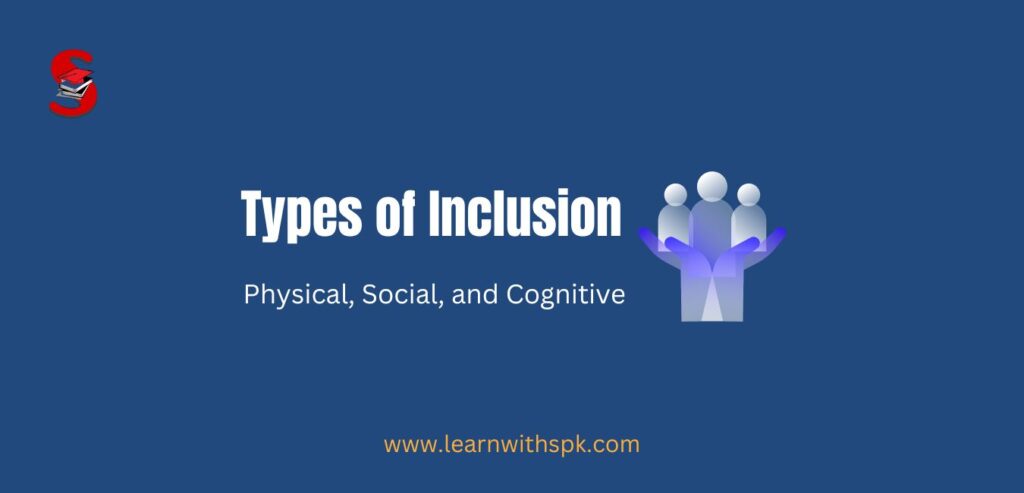What is inclusion? What are the different types of Inclusion? In this article, you will get the answer to all of these questions. Here, we will be discussing on meaning of classification of Inclusion. You will get a detailed explanation of all three types of inclusion namely – physical, social, and cognitive inclusion.

What is Inclusion?
Inclusion is the acceptance of all people regardless of their differences. Inclusion is the creation of an enabling environment that provides for the acceptance of children with and without disabilities to play and interact every day without any prejudices whatsoever, even if these children are receiving therapeutic services.
Types or Classification of Inclusion
There are three different types of inclusion; they are as below-
- Physical Inclusion
- Social Inclusion
- Cognitive Inclusion
#1 Physical Inclusion:
This is the first type of Inclusion. In this type of inclusion, physically disabled children are included. There are seven types of Physical Inclusion. They are –
- Hearing Impairment
- Visually Impairment
- Orthopedic Impairment
- Speech Impairment
- Multiple Impairment
- Cerebral Palsy
- Autism
(a) Hearing Impairment:
Hearing impairments are those who have a damaged auditory sense modality. Any deviation or change for the worse in either auditory structure or auditory function is termed as Hearing Impairment.
(b) Visually Impairment:
Visually disabled children fail to perform visual activities related to daily life; learning and expanding social skills which the average child can learn and perform with quite ease. The impairment may range from low vision to substantial loss of vision or complete loss of sight, i.e., blindness.
(c) Orthopedic Impairment:
These children are commonly known as having physical handicaps, having locomotor difficulties especially attached to the movements of joints, bones, and muscles.
(d) Speech Impairment:
Speech impairment refers to minor or major speech and language problems. Many variations in the speaking difficulties in children exist. Stammering and stuttering result in defective language development with particular deficits in articulation, spelling, and grammar usage.
(e) Multiple Impairment :
Multiple impairments mean that the child has more than one disability. One child can be both deaf and dumb, deaf and blind, blind and crippled legs, orthopedically disabled with intellectual impairment, and so on.
(f) Cerebral Palsy:
Cerebral palsy refers to a group of no-progressive conditions of a person characterized by abnormal motor control, muscle incoordination, and defective posture, which result from brain insult or injuries that occur in the prenatal, prenatal, or early postnatal period of development.
(g) Autism:
Autism is a complex neurobehavioural condition. That includes impairments in social integration and developmental language and communication skills combined with rigid, repetitive behaviors.
Deficiency and delay in speech development, deficit in communication, and difficulties in social development and interpersonal relations are the important disabilities associated with autism.
#2 Social Inclusion:
Social inclusion is a process by which efforts are made to ensure equal opportunities for all, regardless of their background, so they can achieve their full potential in life.
It is a multi-dimensional process. Social Inclusion is aimed at creating conditions that enable full and active participation of every member of society in all aspects of life. It includes civic, social, economic, and political activities, as well as participation in decision-making processes.
Social inclusion aims to empower poor and marginalized people to take advantage of burgeoning global opportunities. It ensures that people have a voice in decisions that affect their lives and that they enjoy equal access to markets, services, and political, social, and physical spaces.
#3 Cognitive Inclusion:
Cognitive inclusion can be understood as a process of giving equal opportunities to children whose I.Q. is below average. They may be classified as below-
- Below-average Intellectual Functioning
- Slow Learner
- Mental Handicapped
(a) Below Average Intellectual Functioning:
The children of this category have I.Q. between 80-90 on standardized tests of intelligence.
(b) Slow Learner:
A child is classified as a slow learner when his/her I.Q. ranges between 70-79 on a standardized test of intelligence. A slow learner tends to take longer to understand things than the average person, or someone who requires multiple explanations before they get a concept.
(c) Mental Handicap:
A mentally handicapped child has an IQ of 70 or below. They have gross problems with learning and adjustment. Furthermore, Mental Handicaps can be divided into the following categories-
- Mild Mental Handicap
- Moderate Mental Handicap
- Severe Mental Handicap
- Profound Mental Handicap
(i) Mild Mental Handicap:
The range of IQ in these children is 51-70, and they in many respects are similar to their peers who are not impaired but have learning difficulties.
(ii) Moderate Mental Handicap:
The children in this category have an I.Q. range between 36-50. Their delayed development is very obvious. However, they can be trained to learn some simple vocational tasks.
(iii) Severe Mental Handicap:
Children need some special care and are more developed than others. They can be trained to execute basic activities of self-care and can perform very simple tasks under supervision. Their range of IQ is between 20-35.
(iv) Profound Mental Handicap:
The children whose I.Q. is below 20 are referred to as Profound Mental Handicap. They are called ‘life support mentally retarded children’, and all aspects of their personality development are grossly impaired. However, these children are unable to take care of their basic needs and always need custodial help.
Hope this will be helpful to you. This article will help you to understand the classification or types of Inclusion. We have also published a post on the characteristics of inclusive education.